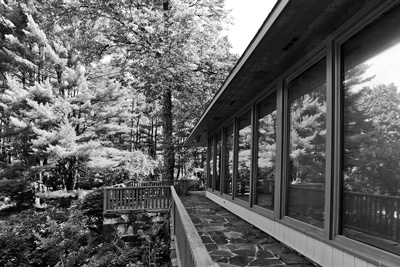Arts and Culture July 2015
Mold forces removal of artwork
Georgi Museum seeks funds for repairs, restoration
By EVAN LAWRENCE
Contributing writer
SHUSHAN, N.Y.
The Georgi Museum has closed and more than 60 works of art have been removed from the property while the museum’s leaders raise funds to remedy a mold infestation. George Bouret photo
An infestation of mold has forced the Georgi Museum to close and relocate much of its collection while it tries to raise funds to repair its building and restore some damaged artwork.
More than 60 vulnerable works of art on wood, fabric, and paper have been loaned out or transferred to climate-controlled storage until the building can reopen.
The Georgi’s collection includes European, Oriental and contemporary art works as well as an extensive array of gems and minerals. The Georgi family left the collection and the museum building, a former home, to the town of Salem in the late 1980s.
“The musty odor has been noticeable for a few years,” said Harold “Butch” Gilchrest, a Salem town councilman. “We needed work done on the building, and we needed to get the art out of there to do it.”
Wendy Bordwell, who took over as the museum’s director about 18 months ago, said mold had become visible on the fabric wall of one room and on the surface of some of the paintings.
“I found it was hard not to notice the mold,” she said.
The museum building was constructed in the early 1950s on a picturesque bend of the Batten Kill. Henry and Jessie Georgi lived a few hundred feet away on Main Street and used the little house as their fishing cottage. No one lived there until Jessie moved in after Henry’s death in 1980, Gilchrest said.
The building has a dirt-floor crawl space and no mechanical ventilation or air conditioning. Since it became a museum in 1989, its hours have been limited because of lack of staff and the expense of heat during the winter. Last year, Bordwell’s first, it was not open to the public at all.
Over the years, “trees grew over the building,” Bordwell said. “They shade the roof and trap moisture. There’s moss growing on the roof.”
When the remnants of Hurricane Irene struck the region in August 2011, the Batten Kill flooded and caused substantial damage to the grounds. The building, however, was above flood level, and neither Bordwell nor Gilchrest thought the storm contributed to the mold.
Town-owned museum
The Georgi is run by a three-person committee whose members are Gilchrest and another town councilman, Bruce Ferguson, and the deputy town historian, Judy Flagg. The Town Board must approve any actions proposed by the committee.
Between an endowment set up by the Georgis and fees for use of the grounds, the property’s operations are self-sustaining, Ferguson said. There is no tax money involved in supporting it.
Bordwell said the decision to close the museum and move out the artwork took about a year. After research, she chose Naglee Fine Arts, a company in Elmira that specializes in conservation storage.
“Naglee is top-notch,” Bordwell said. “The closest comparable facility is in Manhattan.”
In mid-May, a Naglee crew removed 60 paintings from the property. About a dozen small paintings that couldn’t be taken on that run will be transferred later, Bordwell said.
With the artwork safely out of the way, the first task at the building will be removal of the overhanging trees, Bordwell said. The roof will be replaced and the chimney repaired by a local contractor at a cost of $8,000 to $8,500. A decayed railing, a treacherous slate walkway, and handicapped accessibility all must be addressed as part of the project.
Just assessing the mold problem will cost about $1,000, Bordwell said. There’s no estimate yet for what abatement itself will cost. An old estimate for installing climate control for the whole building was about $88,000.
Bordwell said she’s working with GSK Climate Control of Dorset, Vt., for an estimate for climate control of just one section of the structure. An addition that Jessie Georgi put on in the 1980s is mold-free, she added.
The museum’s endowment isn’t big enough to cover all of the needed work, Bordwell said. Because the museum is run by a municipality rather than a nonprofit, it is not eligible for many sources of grant money. Bordwell and the museum committee are putting together a fund-raising plan.
“It will take several layers of effort to restore the building,” Bordwell said. “We’re saying it will be closed for two years. Everyone’s praying it will be less.”
Assessing damaged artwork
Bordwell has been collaborating with Cecilia Esposito, director and curator of the Plattsburgh State Art Museum, to assess the condition of the artwork and find ways to have damaged pictures restored.
Esposito became acquainted with the Georgi collection in the 1980s when she worked at The Hyde Collection in Glens Falls.
“There are several fine 16th century panel paintings that are in immediate need of conservation,” Esposito wrote in an e-mail. “I hope to be able to help the Georgi in working with a conservation lab such as the Williamstown Art Conservation Center to have a review of the works and a proposal for treatment completed.”
While the museum is closed, she added, several of the works are on view at the Plattsburgh State Art Museum, allowing students and the community to see works from periods of European art that aren’t represented in that museum’s collection.
Climate-controlled storage will halt the deterioration of the artworks, but the Georgi has no funds for their restoration.
Bordwell said the Plattsburgh museum, part of the state university system, is sending a few paintings out for assessment and may try to arrange for restoration with its own resources. She’s hopeful corporate sponsors will contribute or that other area museums, such as The Hyde Collection or the Sterling and Francine Clark Art Institute in Williamstown, Mass., may be willing to contribute to the restoration in exchange for a long-term loan of artworks or antique furniture.
The Georgi could perhaps make a deal with an art conservation lab to have student interns do the work under supervision, she said.
Museum required by will
Some of the Georgi’s collection remains at the museum. Oriental porcelains and jade carvings, for example, aren’t affected by mold.
Henry Georgi was a mining engineer who worked in South America, and he left an extensive collection of gems, minerals and mining documents. The most eye-catching specimens are displayed in a cabinet, but the collection includes 11 file drawers and a cardboard box that have never been cataloged, Bordwell said. The Capital Region Gem and Mineral Club began cataloging the collection in June, and this task is expected to take about two months, she said.
Ferguson admitted that the museum “doesn’t draw huge crowds.” Except for local rumors that some of the artwork was looted by the Nazis (Gilchrest said the Georgi family owned it before World War II), or forged (Ferguson said some may be old copies of other works), interest in the art collection has never been high.
Most people who find their way to the Georgi property come for events on the museum grounds -- such as outdoor weddings, concerts, or theater, or recreation such as strolling the grounds, fishing, or boating down the Batten Kill. Jessie Georgi’s two-car garage has become a community room for meetings and art shows, and it remains open.
But under the terms of Jessie Georgi’s will, the town keeps the land only as long as it maintains the house as a museum named for the Georgis, Gilchrest said.
“I don’t think the entire collection will ever be shown at once,” Gilchrest said.
He and Ferguson suggested one room near the front door could be set up as a secure, climate-controlled exhibition space, making the rest of the building available for meetings and possibly offices for local groups such as the Battenkill Conservancy or Battenkill Watershed Alliance.
“That will fulfill the terms of the will and allow other uses of the building,” Gilchrest said. “I think it will work out pretty good.”


